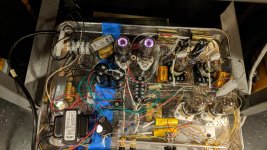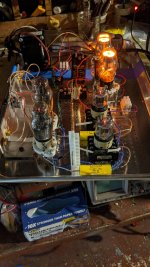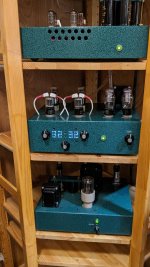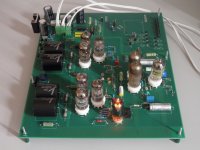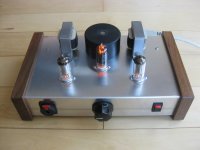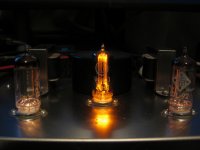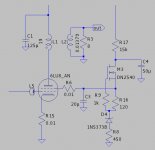Long ago I had a transmitter that had wonderful glowing VR tubes and mercury vapor diodes 😎
I'll pass on the mercury rectifiers, but I would love to have some VR tubes on my next build. is there a practical use for them now? I would feel silly just wiring them up as light bulbs.
I'll pass on the mercury rectifiers, but I would love to have some VR tubes on my next build. is there a practical use for them now? I would feel silly just wiring them up as light bulbs.
You can use them across the B+ to ground to regulate voltage. I am using two OC3 tubes in series to give me 210V regulated. There also OA3 = 75V and OD3 = 150V.
https://frank.pocnet.net/sheets/137/0/0B3.pdf
They do add some novelty.
https://frank.pocnet.net/sheets/137/0/0B3.pdf
They do add some novelty.
Attachments
I use an 85A2 glow discharge reference tube as a voltage reference for my DAC, https://linearaudio.net/sites/linearaudio.net/files/03 Didden LA V13 mvdg.pdf The noise performance is actually pretty good when you look at the ratio of the noise to the DC reference voltage.
Attachments
Last edited:
I built Franks 6SN7 linestage a few years back and used a VR75 and VR150 per channel with dual supplies. They worked fine for me.
A very practical use of gas discharge regulators is in a full pentode mode PP amp employing Russian 6Π15Π "finals". A 0A2 in each channel locks O/P tube g2 voltage at a safe level, while maximizing open loop linearity.
Sockets correctly wired for the 6Π15Π (6p15p) accept EL84s without incident. The key electrical difference between the 6Π15Π and the EL84 lies in g2 toughness. In the 6Π15Π, g2 is fragile. As is often the case with Russian types, specimens bearing the EB (ev) suffix rate to be superior.
Sockets correctly wired for the 6Π15Π (6p15p) accept EL84s without incident. The key electrical difference between the 6Π15Π and the EL84 lies in g2 toughness. In the 6Π15Π, g2 is fragile. As is often the case with Russian types, specimens bearing the EB (ev) suffix rate to be superior.
I built Franks 6SN7 linestage a few years back and used a VR75 and VR150 per channel with dual supplies. They worked fine for me.
From an aesthetic POV, that is one beautiful tube!
Two VR150s in series does a great job of regulating the screen grid voltage for a 6L6 or 807 based amplifier. I suppose you could use them with the 6550 too if you wanted.
Regulating the screens of a pentode or beam power tube amplifier is a great way to improve performance. All it takes is some chassis real estate and sockets, the tubes are quite cheap.
Regulating the screens of a pentode or beam power tube amplifier is a great way to improve performance. All it takes is some chassis real estate and sockets, the tubes are quite cheap.
I used to have a VR75 off the plate supply to make 325V from 400V for my screens in an old 6P3S design 🙂 VR plate to 400V, VR cathode direct to screens and grounded through 100K.
Question: Can I add them together, say a 105 and 150 for 255? What is the strike voltage of 2 of them in series?
The data sheets I linked to in post #2 has info about using them in series.Question: Can I add them together, say a 105 and 150 for 255? What is the strike voltage of 2 of them in series?
I used two OC3s in series to regulate to 210V.
A well-known trick to minimize the strike voltage of two series-connected tubes is to connect a large resistor in parallel with one of them. The one without a resistor then strikes first, at its own strike voltage, and the one with a resistor strikes at its strike voltage plus the maintaining voltage of the other one.
By the way, they also have an ignition delay, especially when they have no radioactive primer and are used in darkness.
By the way, they also have an ignition delay, especially when they have no radioactive primer and are used in darkness.
This looks like a likely candidate for some VR tubes.
6L6 Single Ended Tube Amp | Sarris Custom Tube Amps
6L6 Single Ended Tube Amp | Sarris Custom Tube Amps
- Home
- Amplifiers
- Tubes / Valves
- VR tube dumb question
